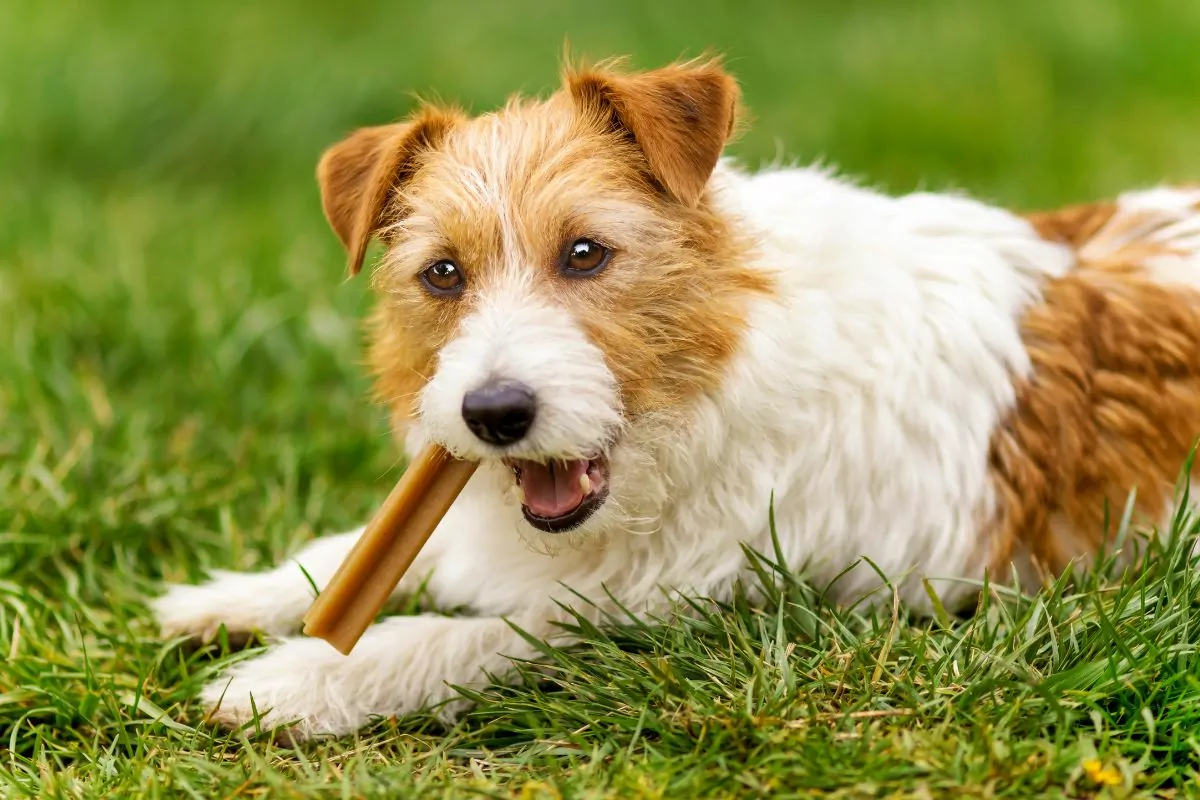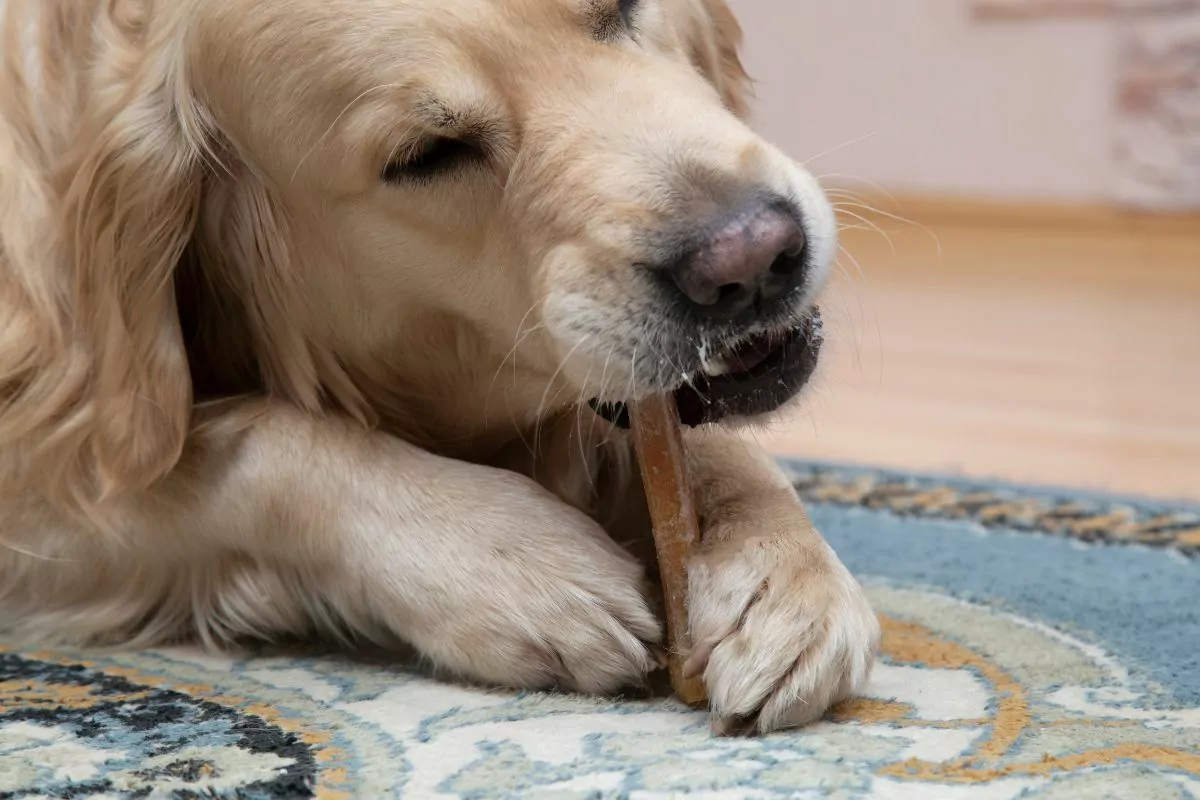Dogs Eating Sticks
Discover why do dogs chew on sticks. Find the science behind it and learn how to protect your home. Click now!
Is It Bad for Dogs to Chew Sticks?
Chewing on a dog stick can be hazardous for some canines. Sticks might splinter, causing damage to a dog’s mouth or digestive system. Offering a safe chew toy instead can provide a healthy alternative for satisfying their natural chewing urge.

Why Do Dogs Chew on Sticks?
This section helps to explain why do dogs like to chew on sticks, offering valuable insights for dog owners.
Smell
Dogs find allure in the variety of aromas sticks possess, including scents from other animals, rain, moss, and bacteria.
Taste
The flavor of sticks may draw dogs to them, enhancing their appeal. Texture: Sticks’ varying textures captivate dogs, creating a tangible sensation.
Physical Activity
Engaging with sticks promotes both physical exercise and mental stimulation.
Fun and Entertainment
Sticks provide a source of amusement and enjoyment for dogs.
Generational Behavior
The tradition of playing with sticks continues through generations of dogs.
Chewing Reduces Anxiety
Dogs might chew on sticks to relieve stress and anxiety.
Foraging Reward
Some dogs engage with sticks as a means of foraging, seeking hidden treats.
Attention Seeking
Interacting with sticks can be a method for dogs to attract their owners’ attention.
Teeth Cleaning
Chewing on sticks serves as an effective teeth-cleaning method.
Can Puppies Chew on Sticks?
While puppy chew sticks might intrigue young dogs, the practice is fraught with risks. Sticks can break into splinters, posing a danger to a puppy’s mouth or digestive tract. Supervising this activity or offering designated chew toys ensures safety without stifling their natural inclination to chew.
How to Stop My Dog From Eating Sticks
Many pet owners wonder, “Is it bad for dogs to eat sticks?” Yes, it can be harmful, as we discovered earlier in this article. To stop your dog from eating sticks, provide safe alternatives and use positive reinforcement when they chew on appropriate items, monitor outdoor play, and consult a professional if needed for further guidance.
Why Do Dogs Love Sticks?
The question of why do dogs chew on wood sticks intrigues many pet owners. This behavior stems from their natural instincts to chew, explore, and play. Wood sticks offer many intriguing aspects, such as stimulating their senses. Chewing on wood sticks can also provide a connection to their wild ancestors.
Can Dogs Eat Bark?
When it comes to a puppy eating sticks, including bark, caution is advised.
- Boredom: Older dogs, especially, might nibble on bark if they feel understimulated.
- Nutritional Deficiency: Some believe dogs might seek out bark due to a lack of certain nutrients.
- Behavioral Issues: Eating non-food items, including bark, could indicate a behavioral condition called pica.
- Teething: For puppies, chewing bark can provide relief from teething discomfort.
- Mimicking Owners: Dogs that observe their owners working with wood or in gardens may mimic this behavior.

Can Dogs Digest Sticks?
The curiosity surrounding why do dogs chew on sticks often leads to the question, ‘Can dogs digest sticks?’
Dogs can’t digest bark for several reasons:
Digestive System Structure
A dog’s digestive system is primarily designed to process meat and some plant materials. Bark is a fibrous and hard substance that doesn’t break down easily in the digestive tract.
Lack of Necessary Enzymes
Dogs do not produce the enzymes necessary to break down cellulose, the primary component in bark. Without these enzymes, the cellulose remains undigested.
Risk of Physical Damage
Bark can splinter into sharp pieces, leading to cuts or abrasions in the mouth, esophagus, or further down the digestive system. Even if it doesn’t crack, the complex nature of bark can cause physical damage.
Potential for Obstruction
If bark or pieces of wood are ingested, they might not pass through the digestive system, leading to obstructions. This could require medical intervention to resolve.
Possible Toxins
Some types of bark contain substances that might be toxic to dogs, posing an additional health risk when ingested.
Is it Safe for Dogs to Play With Sticks?
Playing with a dog stick is an everyday activity, but it’s not always safe. It can be a joyous activity for dogs, but it’s essential to follow certain guidelines to ensure safety:
Choose the Right Stick
Look for sticks that are fresh, solid, and free from splinters. Avoid sticks that are too small and could be swallowed or those that have been treated with chemicals.
Inspect the Stick
Before allowing your dog to play with it, carefully inspect the stick for any sharp edges, splinters, or signs of decay.
Monitor Playtime
Always supervise your dog while they’re playing with a stick. If they start chewing too aggressively, it may be time to take the stick away.
Teach Proper Behavior
Training your dog to fetch and carry the stick gently in their mouth can prevent them from chewing on it and potentially swallowing splinters.
Know Your Dog
Some dogs may be more prone to aggressive chewing. If that’s the case, avoiding sticks and opting for safer chew toys might be best.
Check the Area
Ensure the play area is free of sharp rocks or glass debris that could injure your dog while chasing a stick.
Clean Up
After playing, check your dog’s mouth and paws for any small splinters or injuries, and clean them properly if necessary.
Consider Alternatives
Many pet stores offer stick-like toys designed for safe play and chewing. These can be a great alternative to natural sticks.
By following these tips, playing with sticks can be an enjoyable and safe experience for both dogs and their owners, satisfying the natural instincts of dogs without risking their health.
Some Canine Alternatives to Sticks
The habit of a dog eating sticks can pose risks, so finding safe alternatives is essential. Some canine alternatives to sticks include:
Chew Toys
These toys are crafted from elements designed for safe chewing.
Rope Toys
Offering a similar texture to sticks, these are great for tugging and chewing.
Edible Chews
Options like bully sticks are safe for consumption and provide satisfying chew experiences.
Durable Balls
Heavy-duty balls designed for dogs can offer endless entertainment and are tough enough to withstand chewing.
Raw Hides
Though they can be a controversial choice, raw hides are often used as chewable items. It’s crucial to choose high-quality, untreated options and supervise usage.
Soft Plush Toys
Suitable for gentle chewers, these toys provide comfort.
Interactive Toys
Engage your dog mentally with toys that dispense treats or involve problem-solving.
Professional Guidance
If the habit of chewing sticks persists, a pet behavior specialist may provide specific solutions.
These alternatives cater to various dog preferences and needs, ensuring safe and satisfying play without the risks associated with sticks.

Final Verdict
Understanding why do dogs chew on sticks is vital for every dog owner. This natural behavior stems from various factors like taste, texture, and instinctive drive. While chewing on sticks can provide entertainment and even some dental benefits for dogs, it also poses potential risks, such as splinters, obstructions, and exposure to toxins.
By recognizing why this behavior occurs and offering safe alternatives, dog owners can ensure that their furry friends enjoy healthy and satisfying play.
The guidance and insights provided in this article aim to promote the well-being of dogs and a positive bond between pets and their human companions.
